Mad Hedge Technology Letter
March 9, 2020
Fiat Lux
Featured Trade:
(WHY ZOOM HAS BEEN ZOOMING)
(ZM), (VMW), (JNJ), ($COMPQ)

Mad Hedge Technology Letter
March 9, 2020
Fiat Lux
Featured Trade:
(WHY ZOOM HAS BEEN ZOOMING)
(ZM), (VMW), (JNJ), ($COMPQ)

One man's heaven is another man's hell.
Zoom Video Communications (ZM) is the hero of video conferencing software.
Few companies are navigating the coronavirus situation better than Zoom. Their better-than-expected fourth-quarter earnings and forecast is a great omen for the coronavirus driving future demand for the company’s remote-work tools.
Even without the coronavirus, the company is doing spectacularly.
(ZM) delivers best in show teleconferencing services including video meetings, voice, webinars and chat across desktop and mobile devices, and has been the beneficiary of the dreaded coronavirus that has quarantined workers forcing them to rely on Zoom’s video app tools.
The virus has bolted by the 100,000 customer mark with at least 3,500 Corona deaths.
The panic has been overblown, and the same hysteria has seeped into the broader tech market triggering deep selloffs in almost every tech company.
The elevated awareness and adoption of the company’s video conferencing platform will allow the company to post an even better performance next quarter.
The migration into the company’s free app remains robust and it is unclear whether those users can be converted to paying ones. However, paid growth is still hitting on all cylinders.
Revenue crushed it at 78% to $188.3 million from $105.8 million a year ago.
In total, sales in 2019 were $622.7 million, up 88% year-over-year.
Zoom Communications is attracting more influential customers with 81,900 accounts with at least 10 employees, a 61% uptrend from the past year.
VMware Inc. (VMW) and Johnson & Johnson (JNJ) are two of Zoom’s largest accounts.
Zoom's first-quarter revenue guidance was strong as well predicting between $199 million and $201 million.
Another growth lever will be the mobile segment which has signed up more than 2,900 accounts with more than 10 employees in its first year after launch and will shortly be available in 18 countries.
Total operating margins surpassed expectation of 10%, by more than doubling, to 20.4%.
Ultimately, Zoom's robust Q4 results and guidance underline the company's smooth pathway to elevated revenue drivers as the world goes into pandemic mode because of Covid-19.
It was somewhat underwhelming that management cited a limited revenue benefit from the situation with a go-forward increase in costs as usage increases.
That could have been sorted out more delicately and keeping costs down is one of management’s responsibilities.
The positives still outweigh any minor negatives as the company has been able to capitalize by seizing mind share and expanding the funnel.
Zoom Communications has not been able to escape the recent volatility in shares as the 12% boost from a positive earnings report was met with a 13% haircut the following day as the broader Nasdaq was pummeled.
The Covid-19 virus is delivering agony to investors as the swings are simply hard to trade in and out of.
Making it even more difficult is fogging clarity breeding uncertainty stoking wild risk-off moves even when the central bank announced an emergency half-point rate cut.
The current issue is that short term, markets can behave as irrational as ever and trading algorithms are programmed to digest headlines by not only the volume but the potency and relevancy as well.
If every news wire sent out a story that free money was dropping from the sky, the market would be up 10% irrespective of whether it is true or not.
That is the world we live in where over 85% of the trading decisions and volume are executed by automated software and the exaggeration doesn’t discriminate in which direction it trends in.
So, we are stuck in this negative feedback loop where national headlines are almost entirely concentrated on the coronavirus and that is mainly the data that is fed into short-term trading algorithms.
Unfortunately, the tech market weakness is becoming a self-fulfilling prophecy and new headlines of Northern Italy being quarantined and New York announcing a state of emergency is poised to be the next catalyst for a volatile upcoming trading week ahead.
Short-term traders need to understand that this isn’t just a “buy the dip” event and the deep in the money call spreads that had cushions of 8-10% were blown out in just a few days.
Long term investors should be using every dramatic selloff to add slightly to their positions incrementally lowering their cost basis.
It is hard to know when the coronavirus phenomenon will pass by but at the speed in which we are trending, U.S. school cancelations and further cities and states announcing highly negative events are in the pipeline for next week.
The bottoming event could eventually come in the form of US Corona cases topping 10,000 or cancelling the Olympics in Tokyo, but until then, the negative health headlines appear to be the new normal for the short-term and until we are fully washed out.
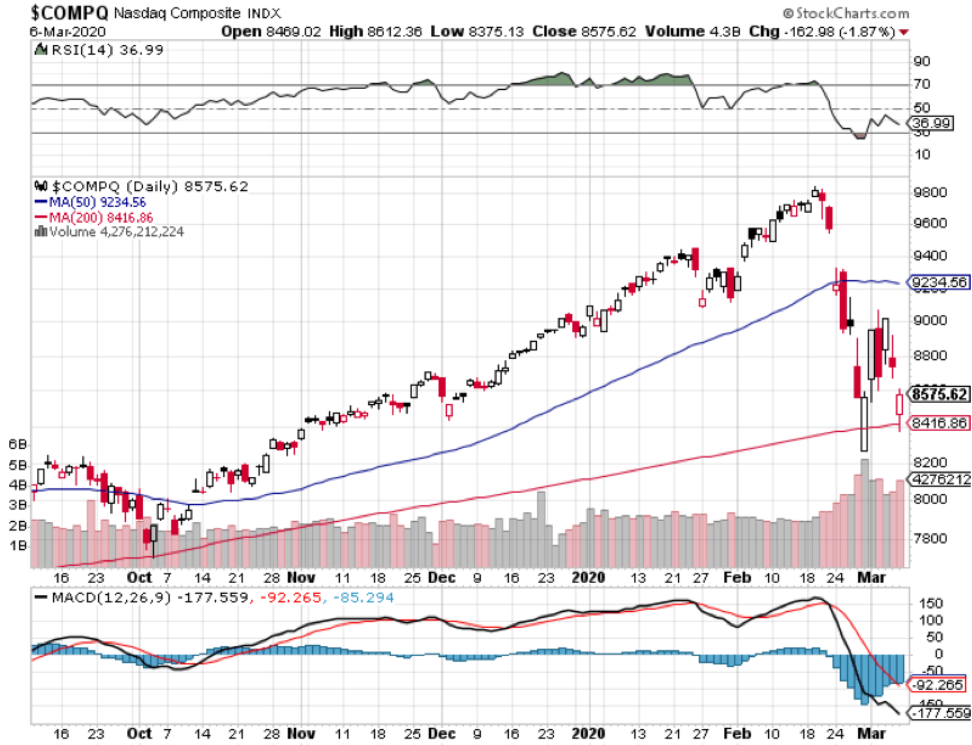
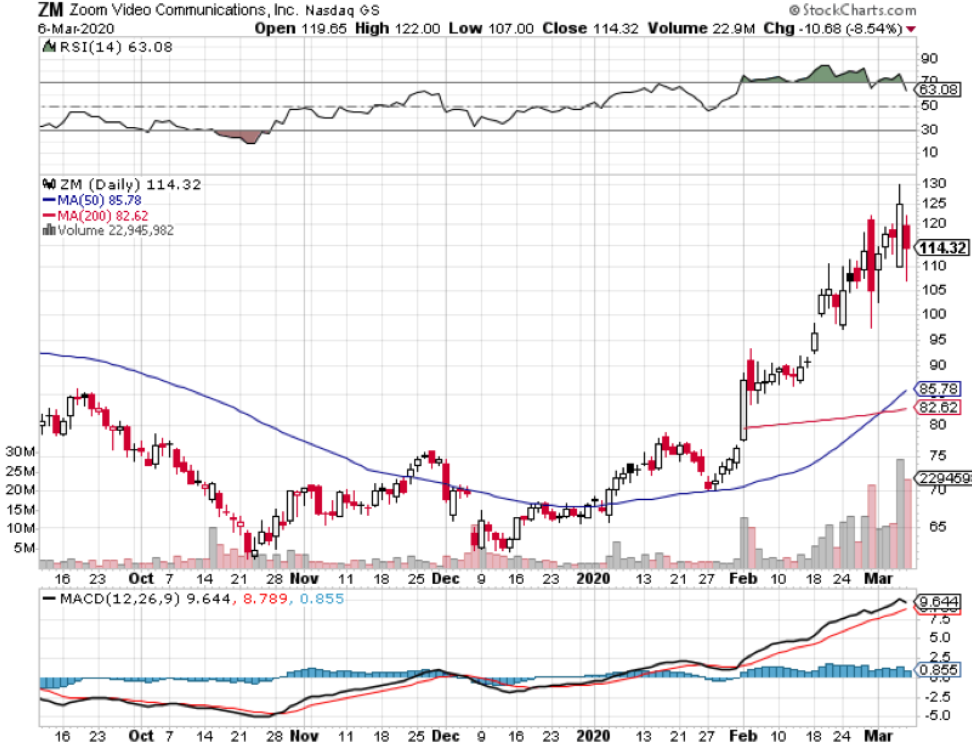
Mad Hedge Technology Letter
March 4, 2020
Fiat Lux
Featured Trade:
(THE BEST TECH STOCKS TO BUY AT THE BOTTOM)
(NFLX), (ZM), (PTON), (AMZN), (OKTA), (WORK), (ATVI), (EA), (TTWO)

Tech stocks that are begging to be picked up on the back of the coronavirus pandemic are Netflix (NFLX), Zoom Video Communications (ZM), workplace collaboration service Slack Technologies (WORK), and Peloton Interactive (PTON), the spin bike company.
Their short-term outperformance indicates that these stocks work well during mass pandemics shelving most outdoor activity and commerce.
The basket of 3 stocks has easily beat the S&P 500 since the coronavirus emerged as a threat in mid-January.
Home sitting doesn’t generate a net output of business activity unless that job is digital.
The majority of workers still commute in a physical car only to sit in an office, restaurant, or some other type of self-contained space.
That is the underlying problem that has no solution, and any rate cut by the Fed cannot ultimately solve consumers holed up in their house.
If the companies that could opt to go pure digital do take up the option, the number of remote workers would rise and digital products would be the ultimate beneficiary of this trend.
Companies that promote remote working such as Slack (WORK) and Google Hangouts are in pole position to reap the rewards.
These services include video conferencing software, logistical services, administrative services, network security services, ecommerce and any service that aids in generating digital content like Adobe and its umbrella of assets.
The trend was already transforming American culture, but the virus vigorously pulls forward a trend that was already in overdrive.
Enabling information workers to produce outside the traditional office environment is one of the lynchpins of the Silicon Valley model.
Companies will ultimately realize that spending big bucks on business travel to meet face to face for 30 minutes is probably not an optimal allocation of resources.
Business travel is getting cut with a cleaver such as Amazon.com (AMZN) who are forcing employees to avoid all nonessential travel for now, including within the U.S. Much of that travel could be replaced by video calls.
Other companies will get in on the action by directing their employees to work from home in the coming weeks.
Coronavirus mania has reached the U.S. shores with consumers stocking up on all the essentials at the local Costco.
If this gets worse, there is no solution unless a viable medical solution starts improving the health crisis.
There are still only 7 known fatalities from the coronavirus, all in the state of Washington, and limiting that number is critical to the health of the tech market.
Another company is Okta (OKTA), a leader in authentication security cloud software.
The company’s offering allows employees to use corporate applications on-site and remotely and protecting their access to their digital services is just as important as the work itself.
As consumer spurn movie theaters, concerts, and gyms, the entertainment space will give way to digital entertainment that includes Netflix (NFLX) and Roku (ROKU).
Roku is a great place to hide out in the world where Covid-19 meets daily consumers in the U.S. in a more meaningful way during 2020.
Netflix is a company that has defied gravity this year by bull-rushing its way through the competition and proving there is space for everyone.
The increase in incremental demand for digital content will only help Netflix claim a bigger part of the pie.
We can also lump the videogame industry into this cohort such as Activision Blizzard (ATVI), Electronic Arts (EA), and Take-Two Interactive Software (TTWO).
They have faced serious headwinds from gaming phenomenon Fortnite, but prolonged home sitting will even boost their shares.
The spine of digital services will receive a boost as well from the usual cast of characters such as Microsoft (MSFT), Apple (AAPL), Alphabet (GOOGL), and Facebook (FB).
As investors wait for the climax of the coronavirus and the Central Bank has indicated that they are open to more accommodative policy, we could be ripe for more volatility.
Chinese coronavirus cases have started to taper off and if the rest of the world trends in a similar fashion, this virus scare could be in the history books in 2-3 months.
However, the trajectory of the virus is still a massive unknown in the U.S. and winning the health battle is the only panacea to this dilemma.
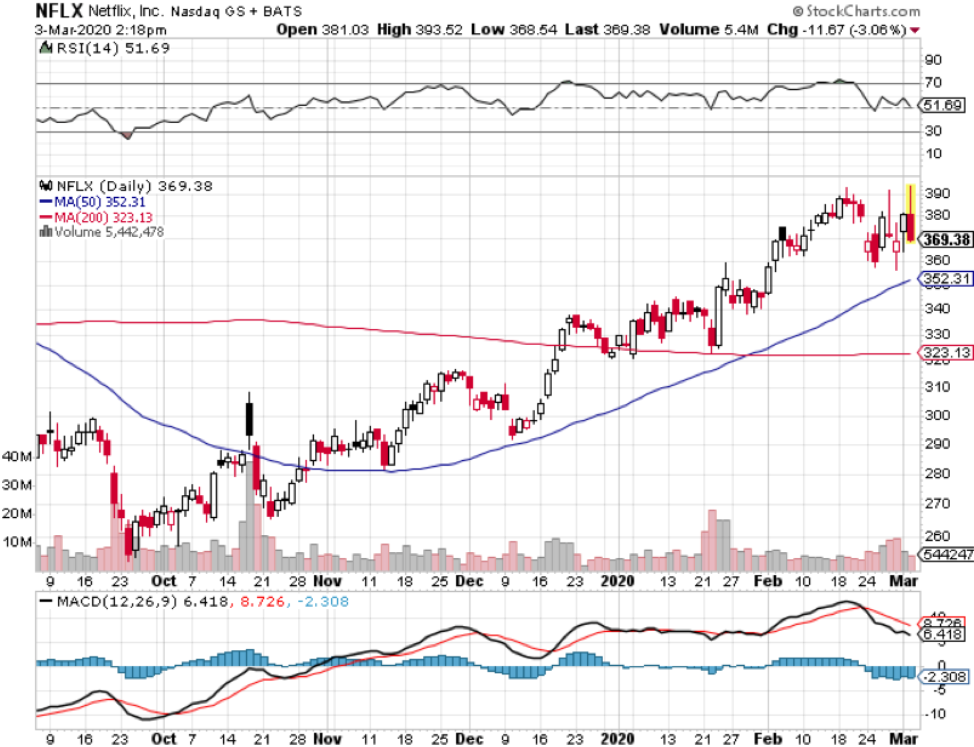
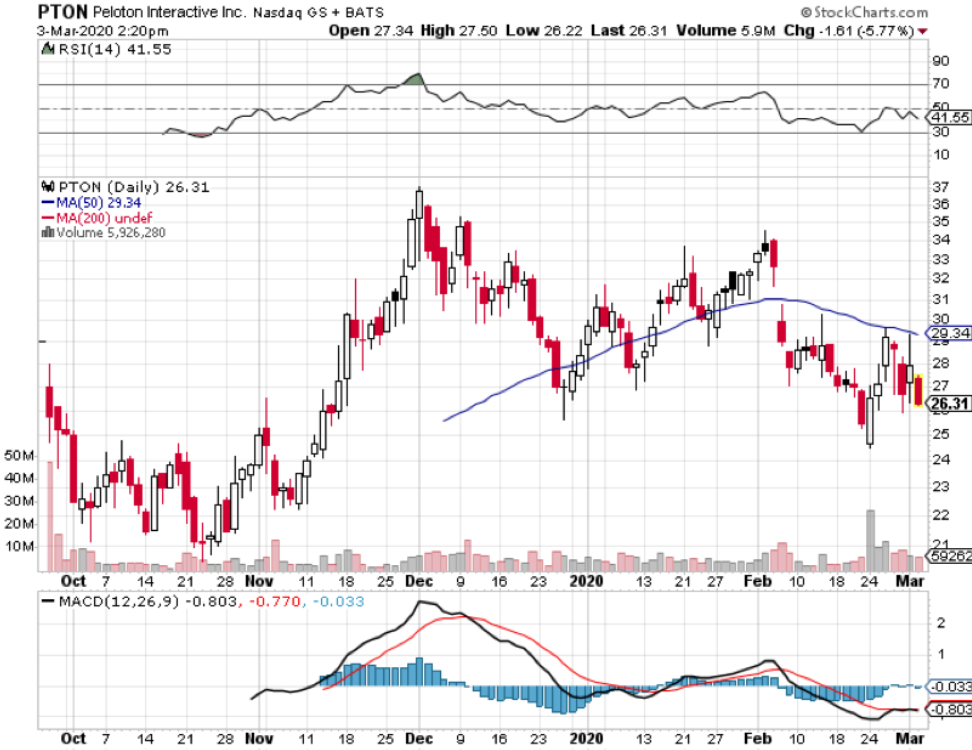
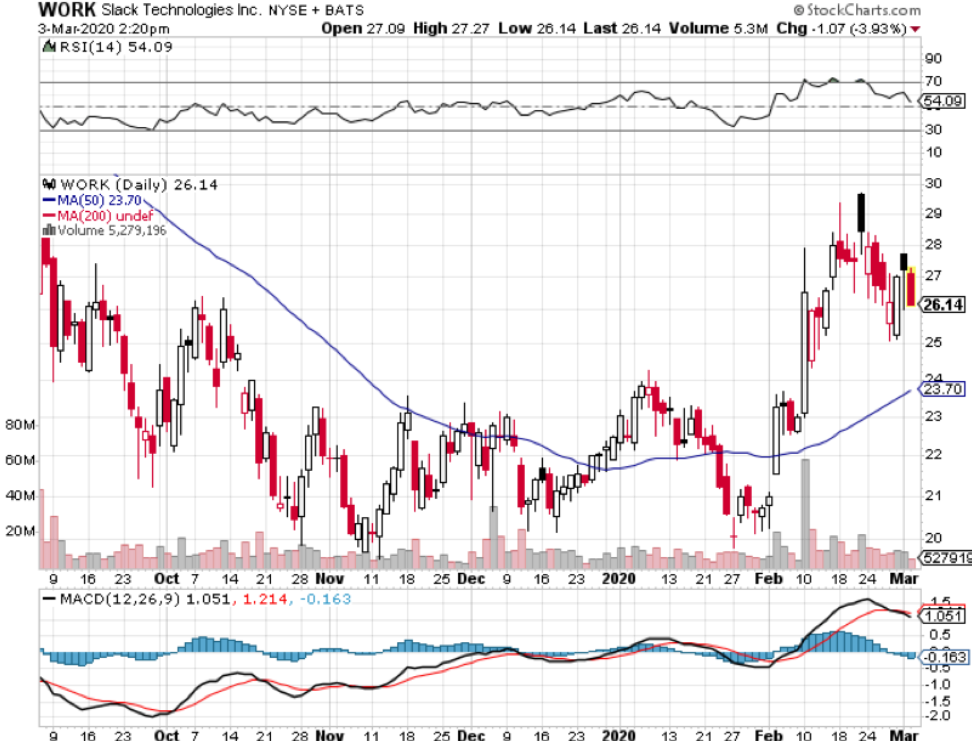
Mad Hedge Technology Letter
February 5, 2020
Fiat Lux
Featured Trade:
(HOW TO TRADE THE CORONAVIRUS)
(APPL), (MSFT), (TSLA), (MU), (WDC), (ZM)

Like a powerful mule, I believe the American tech sector will muscle through the shock of the China coronavirus.
The tech sector will do what it does best, take the lead and put the entire American economy on its back and carry it through when doubts of decelerating global growth are asked of it.
I quantify this as an opportunity for the American tech sector.
Let’s look at some of the short-term contagion American tech companies are absorbing, as well as some opportunities in tech delivered by this sad pandemic.
Apple (AAPL) has made the decision to shutter all Apple stores in mainland China.
Their corporate offices have also gone into sleep mode and that means 10,000 people will need to make do with work stoppages which also include the component makers that supply Apple.
The stoppage is until February 9th, but only if the coronavirus has been effectively thwarted.
The Chinese populace isn’t willing to go out on the street and have barricaded themselves inside their apartments to avoid catching the virus.
Quarantining large areas is an unprecedented move from the Chinese communist party highlighting the poor handling of the situation in the early stages.
China is a critical revenue driver for Apple constituting 15% of revenue.
The delay in manufacturing will result in 3% of iPhone unit shipments being pushed out from March to June.
However, if the lockdown spills into late February or March, then there will be a major hit to the Chinese consumer which could muddy Apple’s bottom line.
Apple’s supply chain could get up-and-running if the shutdown lasts a few weeks but if we are talking months then project dates could get put on the permanent back burner.
Apple is arguably the most prominent American tech company to be affected deeply by the coronavirus but there are others.
The Chinese communist party has put the operation of the new Shanghai Tesla (TSLA) factory on ice which will delay the company’s production of the Model 3 there.
The ramp-up of the Model 3 production will be delayed by a week and a half and the shutdown may “slightly” impact the company’s profitability in the first quarter of 2020, said Tesla’s finance chief Zach Kirkhorn.
As of now Tesla has estimated a 10-day delay to the Shanghai-built Model 3s due to a government-required factory shutdown and the facility will remain locked until February 9th.
Tesla have been churning out cars at its Shanghai factory only since the end of 2019.
The deliveries are an emerging revenue driver as Tesla hopes to gain a foothold in China, the world’s largest market for electric vehicles.
Fortunately, Shanghai-produced Teslas only make up a tiny part of Tesla’s overall revenue, meaning there will be minimal impact to the financials.
The outbreak could have a positive effect for some domestic semiconductor companies.
The chaos resulting from the virus will likely upset operations at Wuhan-based Yangtze Memory Technologies Co. and Wuhan Xinxin Semiconductor Manufacturing Corp., who have been stealing market share from their American competitors.
Yangtze Memory Technologies is China’s leading NAND flash memory producer.
NAND chips are the flash memory chips used in USB drives and smaller devices such as digital cameras as opposed to DRAM, or dynamic random access memory, the type of memory commonly used in PCs and servers.
Micron (MU) and Western Digital (WFC) could swoop in to meet the extra demand.
Another company that could seize a great opportunity because of the coronavirus is Zoom Video Communications (ZM).
The CEO of Zoom Video said, “If you cannot travel ... you need to have a very reliable secure tool like Zoom” and product usage “is very, very high since the last of the month, last week. Almost every day - that’s a record usage.”
Since Chinese tech workers are barricading themselves indoors, Zoom has been the tool of choice to collaborate with coworkers who are in the same situation.
Not that the video conferencing software company needed help, I have recommended this company as a solid buy and hold since the stock dipped to $62.
This new boost will pour gas on the flames and the stock price reacted in lockstep by rocketing 15% in just one trading day.
When the likes of Alphabet’s Google, Facebook, Apple, Microsoft, and Ford Motor are ordered to work from home, videoconferencing, online meetings, chat and mobile collaboration services shoot through the roof.
Video conferencing will become a $43 billion total addressable market in the coming years, and I believe Zoom is easily a $150 stock.
In short, the coronavirus will hurt some tech companies short-term, benefits others, and have no effect on tech firms with negligible China exposure.
Facebook is a stock that I recently executed a call spread on, and they are blocked from operating in the mainland and will feel no difference from this virus outbreak.
Looking even deeper into the matter, the short-term hit to revenues will only be temporary unless this virus wipes out most of China.
The most likely scenario is that less than 1,000 people will eventually die from this and 99.9% of that will be deaths in mainland China.
Investors should look at buying on any substantial dip – the tech narrative is still unbroken.

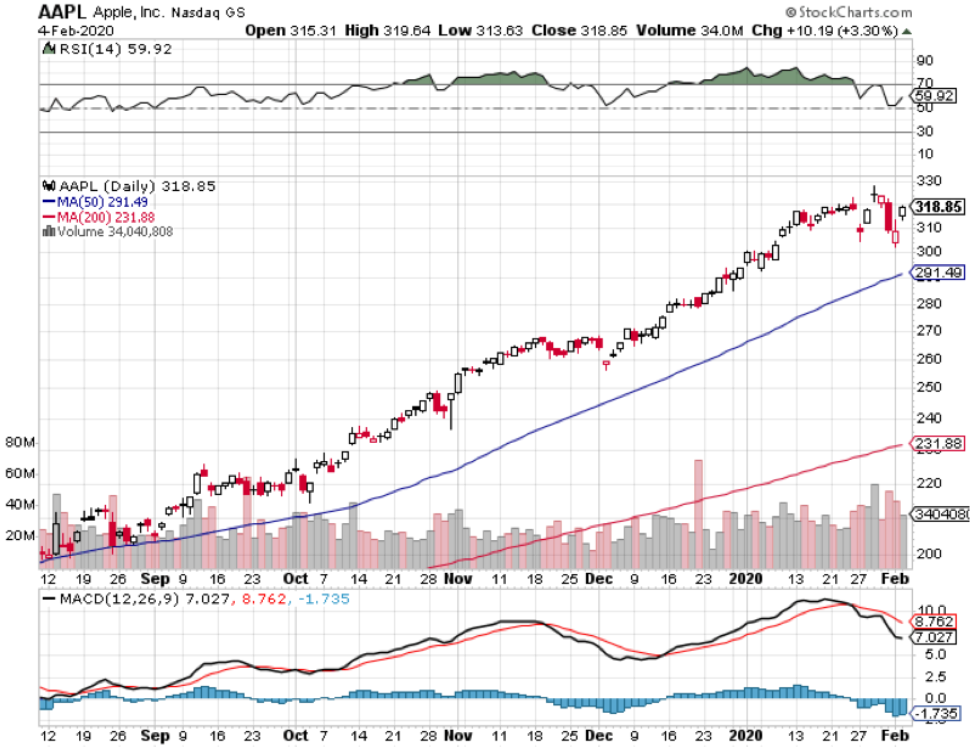
Mad Hedge Technology Letter
January 17, 2020
Fiat Lux
Featured Trade:
(WHY ZOOM IS ZOOMING)
(ZM)

A report from a prominent new source reveals that in the past 12 months, 40% of all US-listed companies were losing money and of these, 17% were tech firms, the highest level since the Dot Com bubble.
That is why software gems like Zoom Video Communications, Inc. (ZM) should be bought and held, never to see the light of day ever again.
The company makes money at such an early stage of their development that it's hard not to get excited about the future.
Readers can indulge themselves in this high caliber tech growth stock, especially after they demonstrated that they are hitting on all cylinders after a high-flying earnings report.
Another prominent new source recently said that this company’s products are “changing the entire landscape” of U.S. business.
Just one instance they have infiltrated deep into real American business is the U.S. Postal Service.
They are starting to deploy Zoom Meetings more broadly across the organization after an extensive proof-of-concept.
The USPS is Zoom’s first major agency and major business win since they received FedRAMP approval in May.
Why did they pick Zoom?
Easy! Simply for Zoom’s high-quality video and audio.
Zoom’s share price cratered 40% since hitting the heights of $102 in July 2019 which was coincidentally the high for most post-IPO tech stocks of 2019.
It was an elevator straight down to no man’s land – but investors would be foolish to paint all hyper-growth companies with the same brush.
Filtering out the wheat from the chaff is critical and Zoom is the stock that still has the gloss on its outside package buttressed by its best-in-show video conferencing software.
There are no other proper alternatives in this sub-sector of software.
The volatility can be extreme making this name difficult to trade and constantly has dips of 7% even though the company crushes expectations.
I called for readers to scoop up shares in the low $60s and the stock is now healthily trading in the upper $70s as we hit the back half of January.
Remember that this company grew 96% just 3 quarters ago and it would be illogical to believe that the stock is being penalized from faltering to 85% today.
The report on January 6th showed a strong quarter as evidenced by a combination of high revenue growth of 85%, with increased profitability and free cash flow of $54.7 million.
They continue to have success with customers of all sizes and one metric that has continued to stick out is customers with more than $100,000 of trailing 12 months revenue – that metric grew 97% from Q3 last year.
Any tech company would give a left thigh for 85% growth in this climate which is why many have resorted to inorganic growth.
Buying growth is not necessarily a bad strategy now but buying growth at this point in the economic cycle naturally means that companies will need to overpay for growth because of expensive valuations.
Zoom is perfectly positioned to outperform in the next 1-3 years.
The advancing runway is wide open with no competition in sight and a generous growth trajectory is firmly on their side.
At some point, this software company could become a takeover target for a larger corporate.
I am impressed with Zoom's superior products, growth prospects, and scalable business model, and the stock’s near-term risk/reward trade-off is mildly bullish after the jump from $62.
There is an actionable and manageable clear path to a $2 billion revenue run rate with strong margin expansion potential and with its flagship product growing around 80-90%, its next growth driver in Zoom Phone could translate well into a meaningful revenue stream.
Zoom Phone is the next springboard to further success for this company, meaning there won’t be any cliff edge with future revenue streams.
Anyone that has used Zoom as a product can confirm the veracity of its superior performance standards.
This isn’t the type of stock to trade short-term - the volatility undermines any potential entry points.
If the broader market holds up in 2020, Zoom’s value extraction potential is substantially robust, and shares should reach $90.
Growth stocks can only be pinned down for so long before the beast is unleashed.
Buy this stock on any short-term dip.
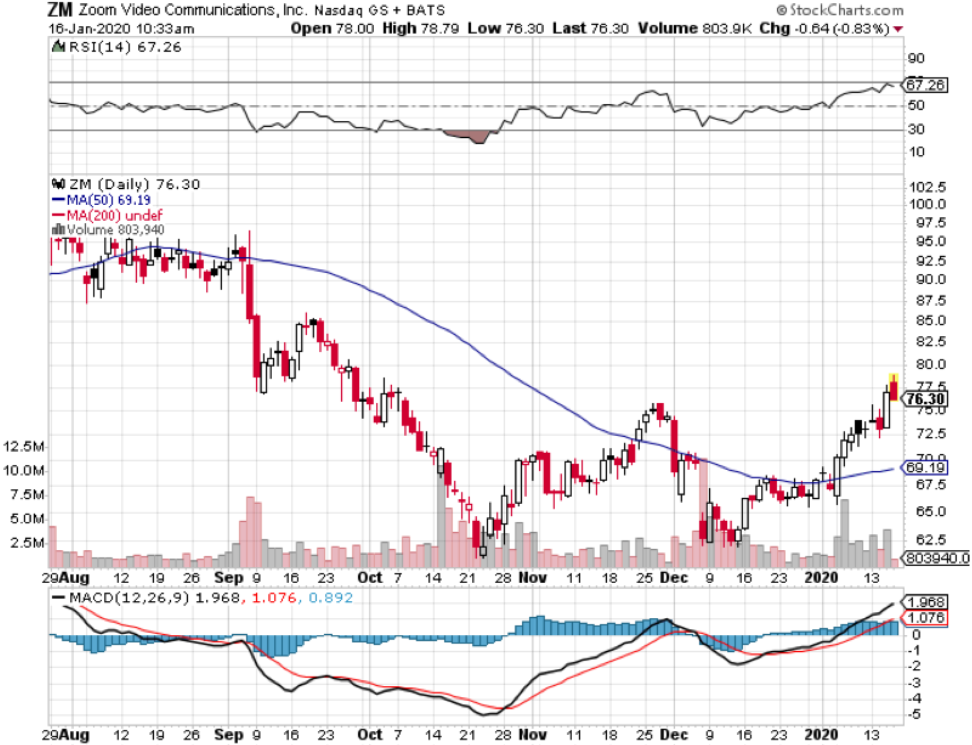
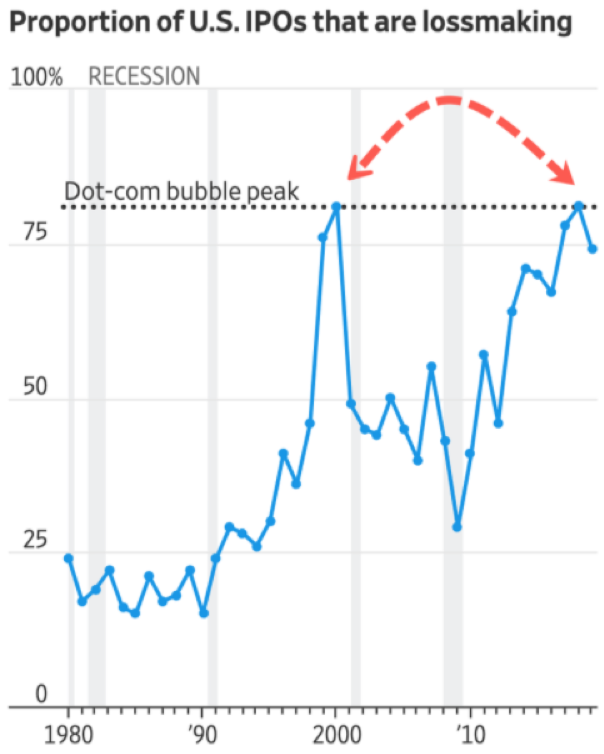
Mad Hedge Technology Letter
December 11, 2019
Fiat Lux
Featured Trade:
(CHERRY-PICKING IN TECH TODAY)
(ZM), (CRM), (GOOGL), (AAPL)

The valedictorian of the IPO class Zoom Video Communications, Inc. (ZM) is finally on sale at a discount.
If readers want to indulge themselves in a high caliber tech growth stock to buy and hold stock, this is the one for you.
This one has no regulatory headwinds as well as an added bonus.
Zoom’s share price has dropped 40% since hitting the heights of $102 in July which was coincidentally the high for most post-IPO tech stocks of 2019.
It’s been an elevator straight down to no man’s land since then, but investors would be foolish to paint all hyper-growth companies with the same brush.
Filtering out the wheat from the chaff is critical and Zoom is the stock that still has the gloss on its outside package buttressed by its best in show video conferencing software.
There are no other proper alternatives in this sub-sector of software.
A few days ago, the stock slid 9% even though the company crushed expectations with its latest quarterly result and outlook.
Zoom generated revenue of $166.6 million representing a growth rate year on year of 85%.
The company then offered a forecast of $175 million next quarter when analysts only estimated $165 million.
Remember that this company grew 96% just 2 quarters ago and it would be illogical to believe that the stock is being penalized from faltering to 85% today.
Any tech company would give a left leg for 85% growth.
Zoom was trading at 33.5 times my calendar 2020 estimates compared to the fast growth software as a service (SaaS) median at 12.9 times.
Then software stocks started indiscriminately selling off on earnings over the past few weeks irrelevant to the quality of news because of worries to the broader bull market in tech stocks.
It’s true that tech stocks aren’t cheap now, and the skittishness rears its ugly head when bullet-proof earnings’ results are met with a cascade of selling.
Salesforce (CRM) was a software company that was penalized for pricey M&A because the company has been unable to organically grow forcing them to buy growth.
Buying growth is not necessarily a bad strategy but buying growth at this point in the economic cycle naturally means that companies will need to overpay for growth because of expensive valuations.
Zoom is perfectly positioned to outperform in the next 2-3 years.
The advancing runway is wide open with no competition in sight and a generous growth trajectory is firmly on their side.
We Company singlehandedly destroyed positive biased market momentum for any tech growth stock this summer, but on the bright side, quality post-IPO growth stocks are more reasonably priced with compelling entry points.
At around $60, Zoom looks appetizing and is a convincing buy and hold. At some point, this software company could become a takeover target for a larger corporate because companies such as Google (GOOGL) and Apple (AAPL) will need to acquire growth moving forward.
I am impressed with Zoom's superior products, growth prospects, and scalable business model, and the stock’s near-term risk/reward trade-off is attractive after the 9% haircut this past week.
There is an actionable and manageable clear path to a $2 billion revenue run rate with strong margin expansion potential and with its flagship product growing around 80-90%, its next growth driver in Zoom Phone could translate well into a meaningful revenue stream.
Zoom Phone is the next springboard to further success for this company.
Anyone that has used Zoom as a product can confirm the veracity of its superior performance standards.
This isn’t the type of stock to trade short-term, the volatility undermines any potential entry points.
If the broader market holds up in 2020, and Zoom isn’t a $100 stock by yearend, then the stars should align by 2021 because the value extraction potential is substantially robust in Zoom’s business model.
We finally have a reasonable level to scale into Zoom, and if it drops into the $50 range, it’s not just a scale-in type of scenario, investors should buy as much as they can with two hands.
Growth stocks can only be pinned down for so long and the best and brightest have been unfairly penalized with the rest. And let me remind you, this patch of softness in shares is only ephemeral and now is the time to act.
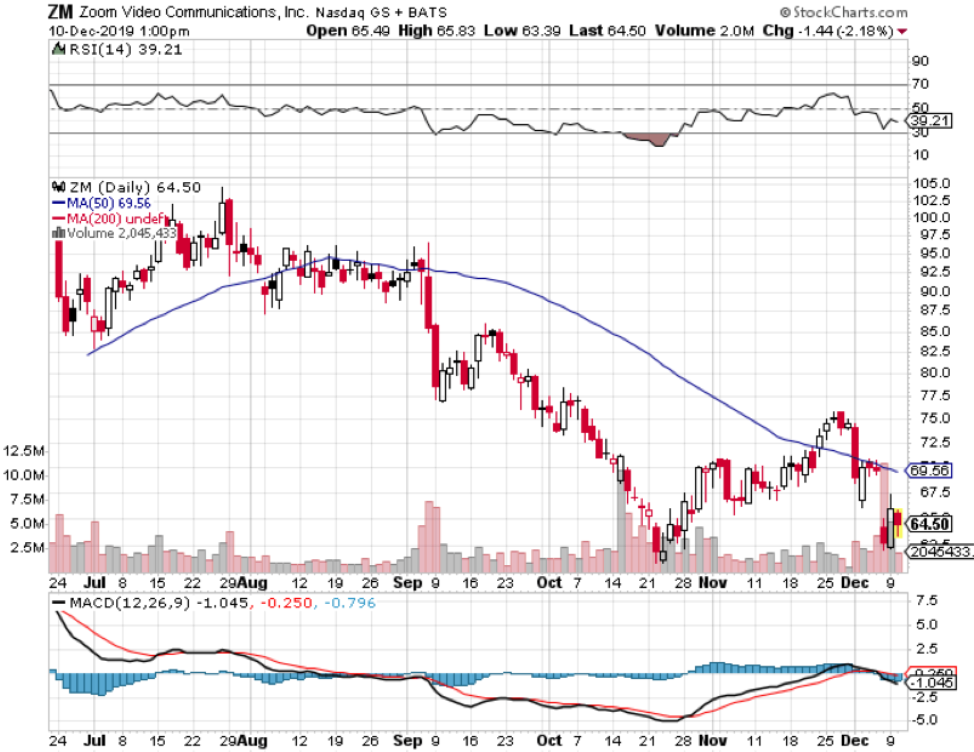
Legal Disclaimer
There is a very high degree of risk involved in trading. Past results are not indicative of future returns. MadHedgeFundTrader.com and all individuals affiliated with this site assume no responsibilities for your trading and investment results. The indicators, strategies, columns, articles and all other features are for educational purposes only and should not be construed as investment advice. Information for futures trading observations are obtained from sources believed to be reliable, but we do not warrant its completeness or accuracy, or warrant any results from the use of the information. Your use of the trading observations is entirely at your own risk and it is your sole responsibility to evaluate the accuracy, completeness and usefulness of the information. You must assess the risk of any trade with your broker and make your own independent decisions regarding any securities mentioned herein. Affiliates of MadHedgeFundTrader.com may have a position or effect transactions in the securities described herein (or options thereon) and/or otherwise employ trading strategies that may be consistent or inconsistent with the provided strategies.
This site uses cookies. By continuing to browse the site, you are agreeing to our use of cookies.
OKLearn moreWe may request cookies to be set on your device. We use cookies to let us know when you visit our websites, how you interact with us, to enrich your user experience, and to customize your relationship with our website.
Click on the different category headings to find out more. You can also change some of your preferences. Note that blocking some types of cookies may impact your experience on our websites and the services we are able to offer.
These cookies are strictly necessary to provide you with services available through our website and to use some of its features.
Because these cookies are strictly necessary to deliver the website, refuseing them will have impact how our site functions. You always can block or delete cookies by changing your browser settings and force blocking all cookies on this website. But this will always prompt you to accept/refuse cookies when revisiting our site.
We fully respect if you want to refuse cookies but to avoid asking you again and again kindly allow us to store a cookie for that. You are free to opt out any time or opt in for other cookies to get a better experience. If you refuse cookies we will remove all set cookies in our domain.
We provide you with a list of stored cookies on your computer in our domain so you can check what we stored. Due to security reasons we are not able to show or modify cookies from other domains. You can check these in your browser security settings.
These cookies collect information that is used either in aggregate form to help us understand how our website is being used or how effective our marketing campaigns are, or to help us customize our website and application for you in order to enhance your experience.
If you do not want that we track your visist to our site you can disable tracking in your browser here:
We also use different external services like Google Webfonts, Google Maps, and external Video providers. Since these providers may collect personal data like your IP address we allow you to block them here. Please be aware that this might heavily reduce the functionality and appearance of our site. Changes will take effect once you reload the page.
Google Webfont Settings:
Google Map Settings:
Vimeo and Youtube video embeds:
